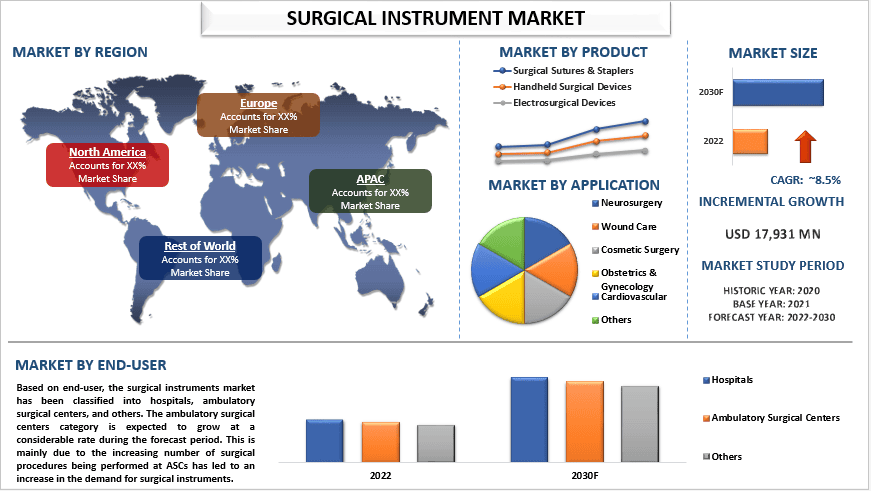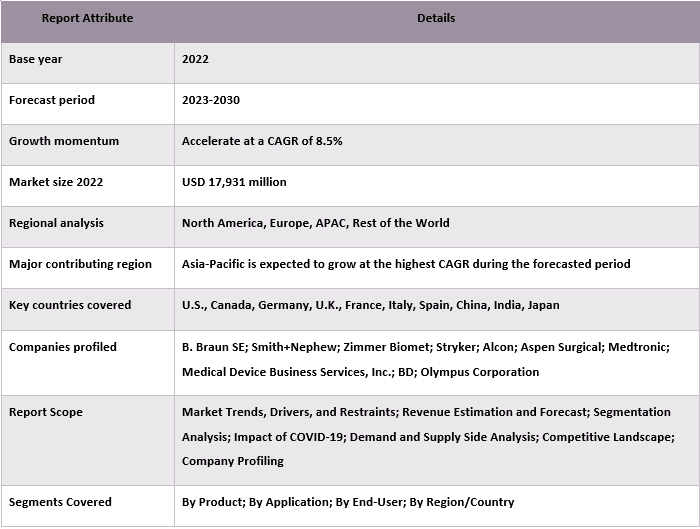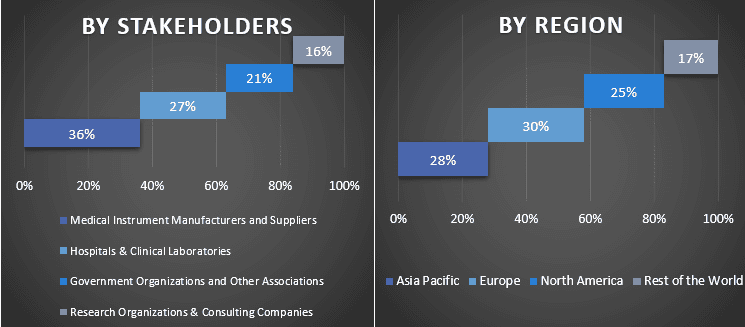- الرئيسية
- معلومات عنا
- صناعة
- الخدمات
- قراءة
- اتصل بنا
سوق الأدوات الجراحية: التحليل الحالي والتوقعات (2023-2030)
التركيز على المنتج (خيوط وغرز جراحية وأدوات تدبيس، وأجهزة جراحية محمولة باليد، وأجهزة الجراحة الكهربائية)؛ التطبيق (جراحة الأعصاب، العناية بالجروح، التوليد وأمراض النساء، القلب والأوعية الدموية، جراحة العظام، وغيرها)؛ المستخدم النهائي (المستشفيات، مراكز الجراحة المتنقلة، وغيرها)؛ والمنطقة/الدولة

بلغت قيمة سوق الأدوات الجراحية 17,931 مليون دولار أمريكي في عام 2022 ومن المتوقع أن ينمو بمعدل نمو سنوي مركب قوي يبلغ حوالي 8.5٪ خلال الفترة المتوقعة بسبب دمج التقنيات المتقدمة، مثل الروبوتات والأدوات الذكية وأنظمة الملاحة الجراحية، مما يعزز الدقة والفعالية. الإجراءات الجراحية، وكذلك صعود مراكز الجراحة المتنقلة التي تقدم بدائل مريحة وفعالة من حيث التكلفة للجراحات التقليدية التي تعتمد على المستشفيات.إن سوق الأدوات الجراحية مدفوع بمجموعة من العوامل التي تشكل مساره. إن الانتشار المتزايد للأمراض المزمنة، إلى جانب الزيادة في التدخلات الجراحية، يدفع الطلب على الأدوات المتخصصة المصممة خصيصًا لتلبية الاحتياجات الطبية المحددة.على سبيل المثال، وفقًا لجمعية القلب الأمريكية، يعاني ما يقرب من نصف البالغين في الولايات المتحدة من نوع من أمراض القلب والأوعية الدموية. بحلول عام 2035، من المتوقع أن يعاني أكثر من 135 مليون بالغ، أو 45.1٪ من سكان الولايات المتحدة، من شكل من أشكال أمراض القلب والأوعية الدموية.علاوة على ذلك، أدى الاتجاه نحو الجراحات طفيفة التوغل، التي توفر فترات تعافي أقصر بعد الجراحة، إلى زيادة الطلب على الأدوات المناسبة لهذه الإجراءات. إن التطورات التكنولوجية، مثل الجراحات بمساعدة الروبوتات ودمج التقنيات الذكية، لا تعزز الدقة الجراحية فحسب، بل تجذب أيضًا المهنيين المهرة الذين يسعون إلى الاستفادة من الأدوات المتطورة. إن توسيع البنية التحتية للرعاية الصحية في الاقتصادات الناشئة يوسع نطاق الوصول إلى التدخلات الجراحية، مما يساهم في نمو السوق.
يشمل بعض اللاعبين الرئيسيين العاملين في السوق B. Braun SE؛ سميث + نفيو؛ زيمر بيوميت؛ سترايكر؛ ألكون؛ أسبن سيرجيكال؛ ميدترونيك؛ خدمات الأعمال للأجهزة الطبية، Inc.؛ بي دي؛ لقد قامت شركة Olympus Corporation بالعديد من عمليات الاندماج والاستحواذ بالإضافة إلى الشراكات من قبل هؤلاء اللاعبين لتزويد العملاء بمنتجات/تقنيات مبتكرة وعالية التقنية.
الرؤى المقدمة في التقرير
"من بين المنتجات، سيطر قطاع الأجهزة الجراحية المحمولة على السوق في عام 2022"
استنادًا إلى المنتج، يتم تقسيم السوق إلى خيوط جراحية وأدوات تدبيس، وأجهزة جراحية محمولة باليد، وأجهزة الجراحة الكهربائية. من بين هؤلاء، سيطر قطاع الأجهزة الجراحية المحمولة على السوق في عام 2022. الأجهزة الجراحية المحمولة هي مجموعة من الأدوات الجراحية المصممة ليتم حملها وتشغيلها بواسطة الجراح أثناء الجراحة. يتزايد الطلب على الأجهزة الجراحية المحمولة بسبب العدد المتزايد من العمليات الجراحية طفيفة التوغل التي يتم إجراؤها في جميع أنحاء العالم. تتطلب هذه العمليات الجراحية أدوات متخصصة يمكن للجراح التعامل معها بسهولة، وقد تم تصميم الأجهزة الجراحية المحمولة خصيصًا لهذا الغرض. أدى التقدم في التكنولوجيا إلى تطوير أجهزة جراحية محمولة أكثر تقدمًا وكفاءة، مما أدى إلى زيادة الطلب على هذه الأجهزة، وبالتالي تعزيز نمو سوق الأدوات الجراحية.
"من بين المستخدمين النهائيين، استحوذت فئة المستشفيات على الحصة الأكبر من سوق الأدوات الجراحية في عام 2022"
حسب المستخدم النهائي، يتم تقسيم السوق إلى مستشفيات ومراكز جراحة متنقلة وغيرها. من بين هؤلاء، استحوذت فئة المستشفيات على الحصة الأكبر من سوق الأدوات الجراحية في عام 2022. تعد المستشفيات أكبر مستهلك للأدوات الجراحية لأن العدد المتزايد من الإجراءات الجراحية وإدارة وحدة العناية المركزة من المتوقع أن يدفع نمو هذا القطاع. أيضًا، يؤدي التشييد المتزايد للمستشفيات إلى زيادة الطلب على الأدوات الجراحية. ومع ذلك، من المرجح أيضًا أن تشهد مراكز الجراحة المتنقلة أسرع نمو خلال الفترة المتوقعة.على سبيل المثال، وفقًا للمسح الوطني للرعاية الطبية المتنقلة في المستشفيات، في عام 2018، استقبل قسم الطوارئ حوالي 130 مليون زيارة، وتم إدخال ما يقرب من 2.3 مليون مريض إلى وحدة العناية المركزة.
"من المتوقع أن تنمو منطقة آسيا والمحيط الهادئ بأسرع معدل نمو خلال الفترة المتوقعة"
في جميع أنحاء منطقة آسيا والمحيط الهادئ، يعكس سوق الأدوات الجراحية النمو السريع للبنية التحتية للرعاية الصحية والتطور الديموغرافي للمرضى. يسعى عدد السكان المتزايد من الطبقة المتوسطة إلى الحصول على رعاية صحية أفضل، مما يؤدي إلى زيادة الطلب على الإجراءات الجراحية. تكتسب التطورات التكنولوجية، مثل الروبوتات والأدوات الذكية، زخمًا في آسيا، مما يدفع الطلب على الأدوات الجراحية المتطورة. يمثل ظهور العمليات الجراحية بمساعدة الروبوتات في المنطقة فرصة مثيرة للسوق. علاوة على ذلك، فإن الارتفاع في انتشار الأمراض المزمنة المرتبطة بنمط الحياة يغذي الطلب على التدخلات الجراحية، مما يحفز الحاجة إلى أدوات متخصصة تلبي الاحتياجات الطبية المتنوعة. نظرًا لأن آسيا تتبنى حلول الرعاية الصحية الحديثة وتصبح مركزًا للسياحة العلاجية، فإن سوق الأدوات الجراحية مهيأ لمشاهدة نمو كبير مع معالجة تحديات الرعاية الصحية الفريدة في المنطقة.
تغطية تقرير سوق الأدوات الجراحية

أسباب شراء هذا التقرير:
- تتضمن الدراسة تحليل لحجم السوق وتوقعاته تم التحقق منه من قبل خبراء الصناعة الرئيسيين الموثوقين.
- يقدم التقرير نظرة سريعة على الأداء العام للصناعة في لمحة.
- يغطي التقرير تحليلاً متعمقًا لأقران الصناعة البارزين مع التركيز الأساسي على البيانات المالية الرئيسية للأعمال، ومحافظ المنتجات، واستراتيجيات التوسع، والتطورات الأخيرة.
- فحص تفصيلي للمحركات والقيود والاتجاهات الرئيسية والفرص السائدة في الصناعة.
- تغطي الدراسة بشكل شامل السوق عبر قطاعات مختلفة.
- تحليل إقليمي متعمق للصناعة.
خيارات التخصيص:
يمكن تخصيص سوق الأدوات الجراحية العالمي بشكل أكبر حسب المتطلبات أو أي قطاع سوق آخر. إلى جانب ذلك، تدرك UMI أن لديك احتياجات عمل خاصة بك، لذا لا تتردد في الاتصال بنا للحصول على تقرير يناسب متطلباتك تمامًا.
جدول المحتويات
منهجية البحث لتحليل سوق الأدوات الجراحية (2023-2030)
كان تحليل السوق التاريخي وتقدير السوق الحالي والتنبؤ بالسوق المستقبلي لسوق الأدوات الجراحية العالمي هي الخطوات الرئيسية الثلاث التي تم اتخاذها لإنشاء وتحليل اعتماد الأدوات الجراحية في المناطق الرئيسية على مستوى العالم. تم إجراء بحث ثانوي شامل لجمع أرقام السوق التاريخية وتقدير حجم السوق الحالي. ثانيًا، للتحقق من صحة هذه الرؤى، تم أخذ العديد من النتائج والافتراضات في الاعتبار. علاوة على ذلك، تم أيضًا إجراء مقابلات أولية شاملة مع خبراء الصناعة عبر سلسلة القيمة لسوق الأدوات الجراحية العالمي. بعد افتراض أرقام السوق والتحقق من صحتها من خلال المقابلات الأولية، استخدمنا نهجًا من أعلى إلى أسفل / من أسفل إلى أعلى للتنبؤ بحجم السوق الكامل. بعد ذلك، تم اعتماد طرق تقسيم السوق وتثليث البيانات لتقدير وتحليل حجم سوق القطاعات والقطاعات الفرعية للصناعة ذات الصلة. يتم شرح المنهجية التفصيلية أدناه:
تحليل حجم السوق التاريخي
الخطوة 1: دراسة متعمقة للمصادر الثانوية:
تم إجراء دراسة ثانوية تفصيلية للحصول على حجم السوق التاريخي لسوق الأدوات الجراحية من خلال المصادر الداخلية للشركة مثلالتقارير السنوية والبيانات المالية والعروض التقديمية للأداء والنشرات الصحفية وما إلى ذلك،والمصادر الخارجية بما في ذلكالمجلات والأخبار والمقالات والمنشورات الحكومية ومنشورات المنافسين وتقارير القطاعات وقاعدة بيانات الطرف الثالث والمنشورات الموثوقة الأخرى.
الخطوة 2: تجزئة السوق:
بعد الحصول على حجم السوق التاريخي لسوق الأدوات الجراحية، أجرينا تحليلًا ثانويًا تفصيليًا لجمع رؤى السوق التاريخية ومشاركة القطاعات والقطاعات الفرعية المختلفة للمناطق الرئيسية. يتم تضمين القطاعات الرئيسية في التقرير كمنتج وتطبيق ومستخدم نهائي. تم إجراء المزيد من التحليلات على مستوى الدولة لتقييم الاعتماد العام لنماذج الاختبار في تلك المنطقة.
الخطوة 3: تحليل العوامل:
بعد الحصول على حجم السوق التاريخي للقطاعات والقطاعات الفرعية المختلفة، أجرينا تحليلًا تفصيليًاتحليل العوامللتقدير حجم السوق الحالي لسوق الأدوات الجراحية. علاوة على ذلك، أجرينا تحليلًا للعوامل باستخدام متغيرات تابعة ومستقلة مثل المنتج والتطبيق والمستخدم النهائي لسوق الأدوات الجراحية. تم إجراء تحليل شامل لسيناريوهات جانب الطلب والعرض مع الأخذ في الاعتبار أهم الشراكات وعمليات الاندماج والاستحواذ والتوسع التجاري وإطلاق المنتجات في قطاع سوق الأدوات الجراحية في جميع أنحاء العالم.
تقدير حجم السوق الحالي والتوقعات
تحديد حجم السوق الحالي:بناءً على رؤى قابلة للتنفيذ من الخطوات الثلاث المذكورة أعلاه، توصلنا إلى حجم السوق الحالي واللاعبين الرئيسيين في سوق الأدوات الجراحية العالمي والحصص السوقية للقطاعات. تم تحديد جميع تقسيمات الحصص المئوية المطلوبة وتقسيمات السوق باستخدام النهج الثانوي المذكور أعلاه وتم التحقق منها من خلال المقابلات الأولية.
التقدير والتوقع:لتقدير السوق والتنبؤ به، تم تعيين أوزان لعوامل مختلفة بما في ذلك المحركات والاتجاهات والقيود والفرص المتاحة لأصحاب المصلحة. بعد تحليل هذه العوامل، تم تطبيق تقنيات التنبؤ ذات الصلة، أي النهج من أعلى إلى أسفل / من أسفل إلى أعلى للوصول إلى توقعات السوق لعام 2030 للقطاعات والقطاعات الفرعية المختلفة عبر الأسواق الرئيسية على مستوى العالم. تشمل منهجية البحث المعتمدة لتقدير حجم السوق ما يلي:
- حجم سوق الصناعة، من حيث الإيرادات (بالدولار الأمريكي) ومعدل اعتماد سوق الأدوات الجراحية عبر الأسواق الرئيسية محليًا
- جميع الحصص المئوية والانقسامات وتقسيمات قطاعات السوق والقطاعات الفرعية
- اللاعبون الرئيسيون في سوق الأدوات الجراحية العالمية من حيث المنتجات المعروضة. أيضًا ، استراتيجيات النمو التي يتبناها هؤلاء اللاعبون للمنافسة في السوق سريع النمو
التحقق من حجم السوق وحصتها
البحث الأساسي:أجريت مقابلات متعمقة مع قادة الرأي الرئيسيين (KOLs) بمن فيهم كبار المديرين التنفيذيين (CXO / VPs ، ورئيس المبيعات ، ورئيس التسويق ، ورئيس العمليات ، والرئيس الإقليمي ، ورئيس الدولة ، وما إلى ذلك) عبر المناطق الرئيسية. ثم تم تلخيص نتائج البحث الأولية ، وتم إجراء تحليل إحصائي لإثبات الفرضية المذكورة. تم دمج المدخلات من الأبحاث الأولية مع النتائج الثانوية ، وبالتالي تحويل المعلومات إلى رؤى قابلة للتنفيذ.
تقسيم المشاركين الأساسيين في مناطق مختلفة

هندسة السوق
تم توظيف تقنية تثليث البيانات لإكمال تقدير السوق الإجمالي والتوصل إلى أرقام إحصائية دقيقة لكل قطاع وشريحة فرعية من سوق الأدوات الجراحية العالمية. تم تقسيم البيانات إلى عدة شرائح وشرائح فرعية بعد دراسة معلمات واتجاهات مختلفة في مجالات المنتج والتطبيق والمستخدم النهائي في سوق الأدوات الجراحية العالمية.
الهدف الرئيسي من دراسة سوق الأدوات الجراحية العالمية
تم تحديد اتجاهات السوق الحالية والمستقبلية لسوق الأدوات الجراحية العالمية في الدراسة. يمكن للمستثمرين الحصول على رؤى استراتيجية لإنشاء تقديرهم للاستثمارات بناءً على التحليل النوعي والكمي الذي تم إجراؤه في الدراسة. حددت اتجاهات السوق الحالية والمستقبلية جاذبية السوق الإجمالية على المستوى الإقليمي ، مما يوفر منصة للمشارك الصناعي لاستغلال السوق غير المستغلة للاستفادة من ميزة المحرك الأول. تشمل الأهداف الكمية الأخرى للدراسات:
- تحليل حجم السوق الحالي والمتوقع لسوق الأدوات الجراحية من حيث القيمة (بالدولار الأمريكي). أيضًا ، قم بتحليل حجم السوق الحالي والمتوقع للشرائح والشرائح الفرعية المختلفة.
- تشمل الشرائح في الدراسة مجالات المنتج والتطبيق والمستخدم النهائي.
- تحديد وتحليل الإطار التنظيمي للأداة الجراحية
- تحليل سلسلة القيمة المتضمنة مع وجود وسطاء مختلفين ، إلى جانب تحليل سلوكيات العملاء والمنافسين في الصناعة.
- تحليل حجم السوق الحالي والمتوقع لسوق الأدوات الجراحية للمنطقة الرئيسية.
- تشمل البلدان الرئيسية للمناطق التي تمت دراستها في التقرير آسيا والمحيط الهادئ وأوروبا وأمريكا الشمالية وبقية العالم
- ملفات تعريف الشركات في سوق الأدوات الجراحية واستراتيجيات النمو التي يتبناها اللاعبون في السوق للحفاظ على استمرارهم في السوق سريع النمو.
- تحليل متعمق على المستوى الإقليمي للصناعة
ذات صلة التقارير
العملاء الذين اشتروا هذا المنتج اشتروا أيضًا










